engine MITSUBISHI ECLIPSE 1991 Service Manual
[x] Cancel search | Manufacturer: MITSUBISHI, Model Year: 1991, Model line: ECLIPSE, Model: MITSUBISHI ECLIPSE 1991Pages: 1216, PDF Size: 67.42 MB
Page 1 of 1216
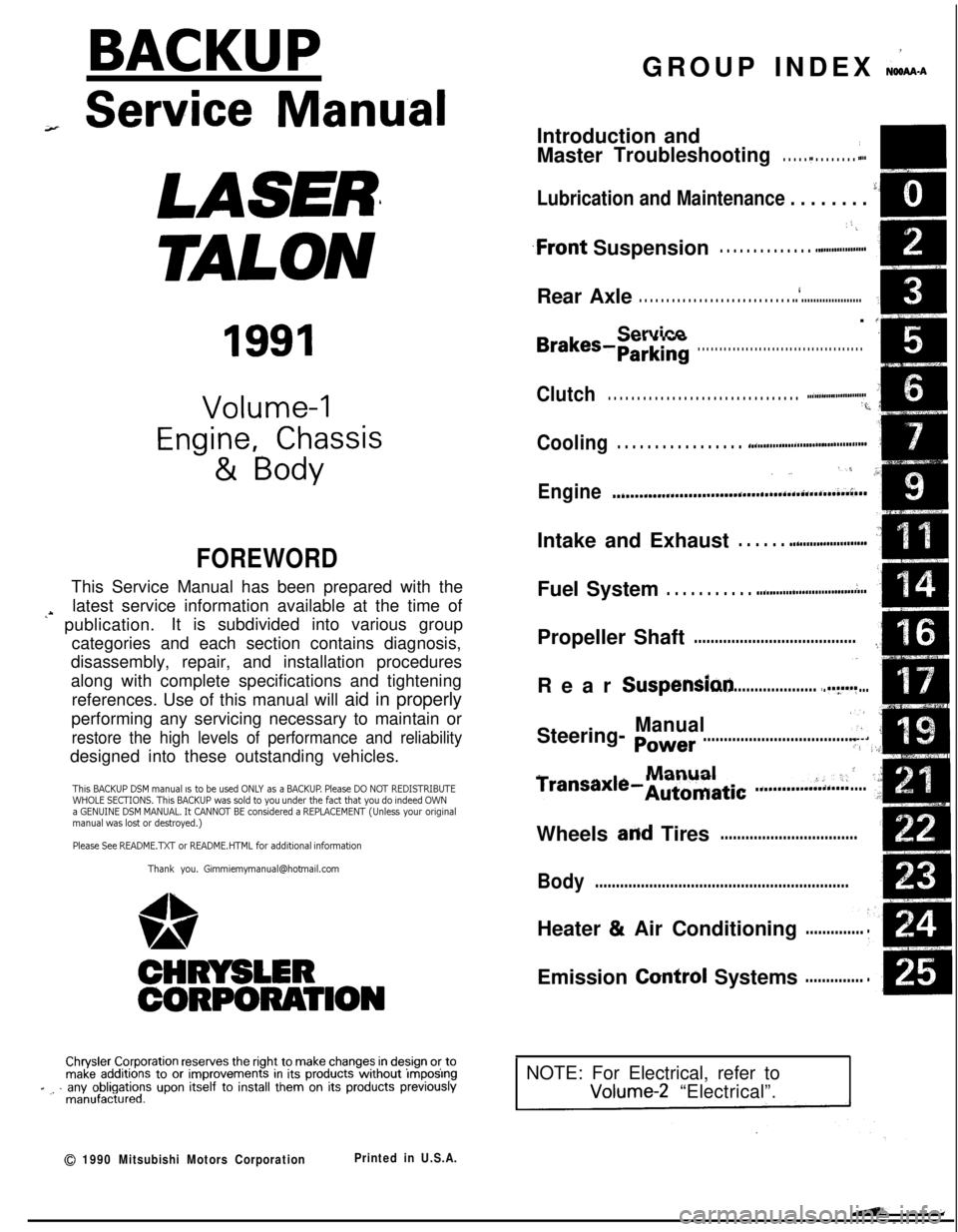
BACKUPGROUP INDEX &ma
;r Service Manual
LASER
TALON
1991
Volume-l
Engine, Chassis
& Body
FOREWORDThis Service Manual has been prepared with the
latest service information available at the time of
‘* publication.It is subdivided into various group
categories and each section contains diagnosis,
disassembly, repair, and installation procedures
along with complete specifications and tightening
references. Use of this manual will aid in properly
performing any servicing necessary to maintain or
restore the high levels of performance and reliabilitydesigned into these outstanding vehicles.
This BACKUP DSM manual IS to be used ONLY as a BACKUP. Please DO NOT REDISTRIBUTEWHOLE SECTIONS. This BACKUP was sold to you under the fact that you do indeed OWNa GENUINE DSM MANUAL. It CANNOT BE considered a REPLACEMENT (Unless your originalmanual was lost or destroyed.)Please See
README.N or README.HTML for additional information
Thank you. G~mm~emymanual@hotma~l.com
1,
wA
CHRYSLER
CORPORATION
Chrysler Corporation reserves the right to make changes in design 0’: tomake additions to or improvements in its products without lmqoslngd ., . any obligations upon itself to install them on its products previouslymanufactured.
0 1990 Mitsubishi Motors CorporationPrinted in U.S.A.Introduction and
Master
Troubleshooting. . . . . .,. . . . . . . . . r...m,
Lubrication and Maintenance . . . . . . . . ‘-0‘8
; “. i,
.Front Suspension. . . . . . . . . . . . . . ..*............d...Rear Axle
. . . . . . . . . . . . . . . . . . . . . . . . . . . . ..‘.....................
/
ServiceBrakes-Parking. . . . . . . . . . . . . . . . . . . . . . . . . . . . . . . . . . . . . .
Clutch. . . . . . . . . . . . . . . . . . . . . . . . . . . . . . . . . ..~......................‘t.
Cooling. . . . . . . . . . . . . . . . . ..i....................................
,., .‘,-,
Engine..i....~....r...............~....~.*,.~.~.~,‘~~...;..~~..Intake and Exhaust
. . . . . . ..L....................Fuel System
. . . . . . . . . . . ..ti.......r................~...Propeller Shaft
.......................................IRear
Suspensiori.............................y.f...
ManualSteering- Power.....................................Manual
I
transaxle-Automatic .............:;i...,;.....;Wheels
and Tires.................................
Body.............................................................Heater & Air Conditioning
..............Emission
Contr6l Systems..............
INOTE: For Electrical, refer toVolume-2 “Electrical”.
Page 2 of 1216
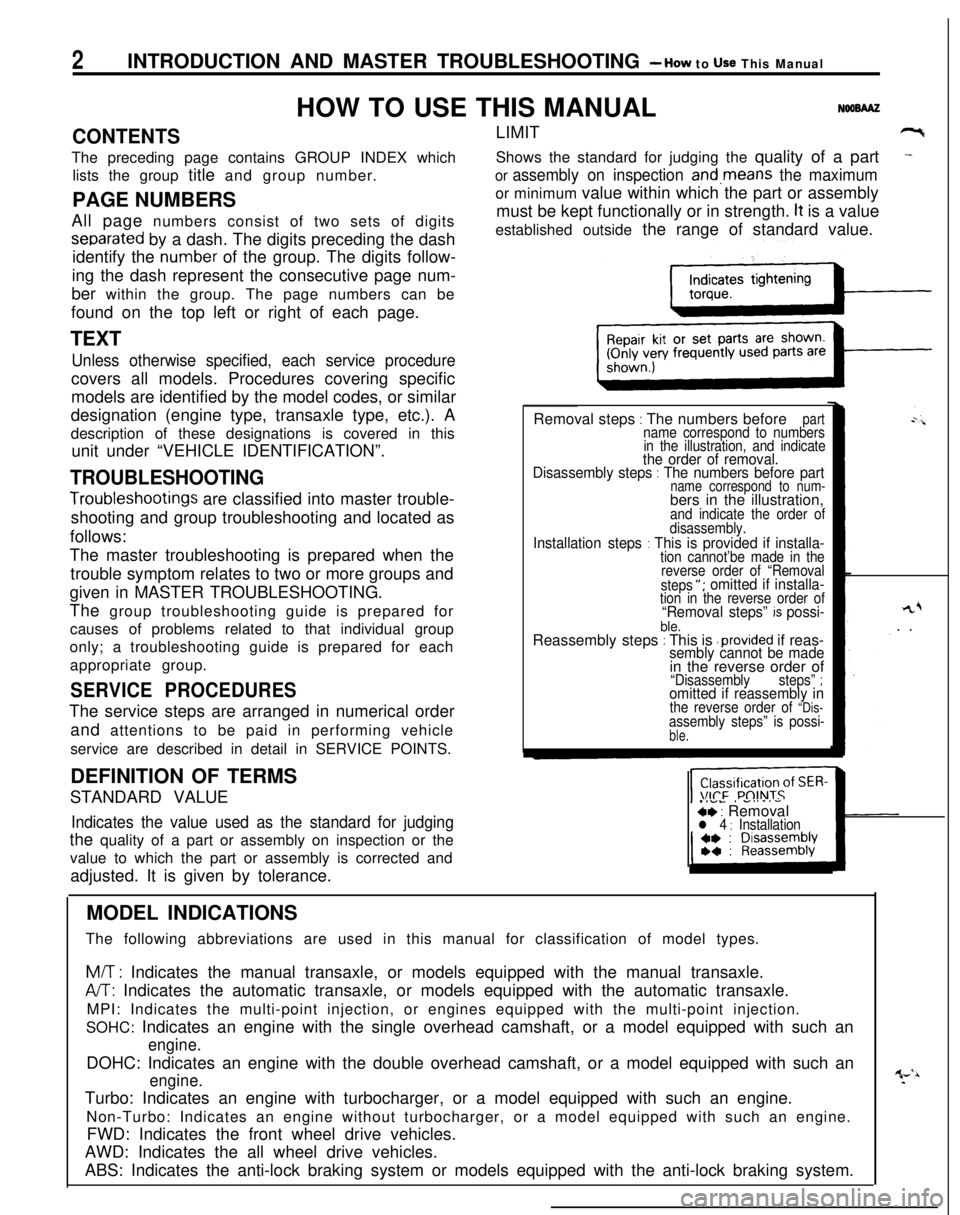
2INTRODUCTION AND MASTER TROUBLESHOOTING - How to Use This Manual
HOW TO USE THIS MANUALNOaM
CONTENTSThe preceding page contains GROUP INDEX which
lists the group title and group number.
PAGE NUMBERS
All page numbers consist of two sets of digits
separated by a dash. The digits preceding the dash
identify the
number of the group. The digits follow-
ing the dash represent the consecutive page num-
ber within the group. The page numbers can be
found on the top left or right of each page.
TEXT
Unless otherwise specified, each service procedurecovers all models. Procedures covering specific
models are identified by the model codes, or similar
designation (engine type, transaxle type, etc.). A
description of these designations is covered in this
unit under “VEHICLE IDENTIFICATION”.
TROUBLESHOOTING
Troubleshootings are classified into master trouble-
shooting and group troubleshooting and located as
follows:
The master troubleshooting is prepared when the
trouble symptom relates to two or more groups and
given in MASTER TROUBLESHOOTING.
The group troubleshooting guide is prepared for
causes of problems related to that individual group
only; a troubleshooting guide is prepared for each
appropriate group.LIMIT
-9Shows the standard for judging the quality of a part
-
or assembly on inspection and,means the maximumor minimum value within which the part or assembly
must be kept functionally or in strength.
It is a value
established outside the range of standard value.
Removal steps
: The numbers beforepartname correspond to numbers
in the illustration, and indicate
the order of removal.
Disassembly steps : The numbers before partname correspond to num-bers in the illustration,
and indicate the order of
disassembly.
Installation steps : This is provided if installa-tion cannot’be made in the
reverse order of “Removal
steps
“; omitted if installa-tion in the reverse order of“Removal steps” k possi-ble.Reassembly steps : This is .provided if reas-sembly cannot be made
rL+. .
in the reverse order of
“Disassemblysteps” ;omitted if reassembly inthe reverse order of “Dis-assembly steps” is possi-ble.
SERVICE PROCEDURESThe service steps are arranged in numerical order
and attentions to be paid in performing vehicle
service are described in detail in SERVICE POINTS.
.IVL, -....-ce : Removall 4 : InstallationDEFINITION OF TERMS
STANDARD VALUEIndicates the value used as the standard for judgingthe quality of a part or assembly on inspection or the
value to which the part or assembly is corrected and
adjusted. It is given by tolerance.
MODEL INDICATIONS
The following abbreviations are used in this manual for classification of model types.
M/T : Indicates the manual transaxle, or models equipped with the manual transaxle.
A/T: Indicates the automatic transaxle, or models equipped with the automatic transaxle.
MPI: Indicates the multi-point injection, or engines equipped with the multi-point injection.
SOHC: Indicates an engine with the single overhead camshaft, or a model equipped with such an
engine.DOHC: Indicates an engine with the double overhead camshaft, or a model equipped with such an
engine.Turbo: Indicates an engine with turbocharger, or a model equipped with such an engine.
Non-Turbo: Indicates an engine without turbocharger, or a model equipped with such an engine.
FWD: Indicates the front wheel drive vehicles.
AWD: Indicates the all wheel drive vehicles.
ABS: Indicates the anti-lock braking system or models equipped with the anti-lock braking system.
Page 6 of 1216
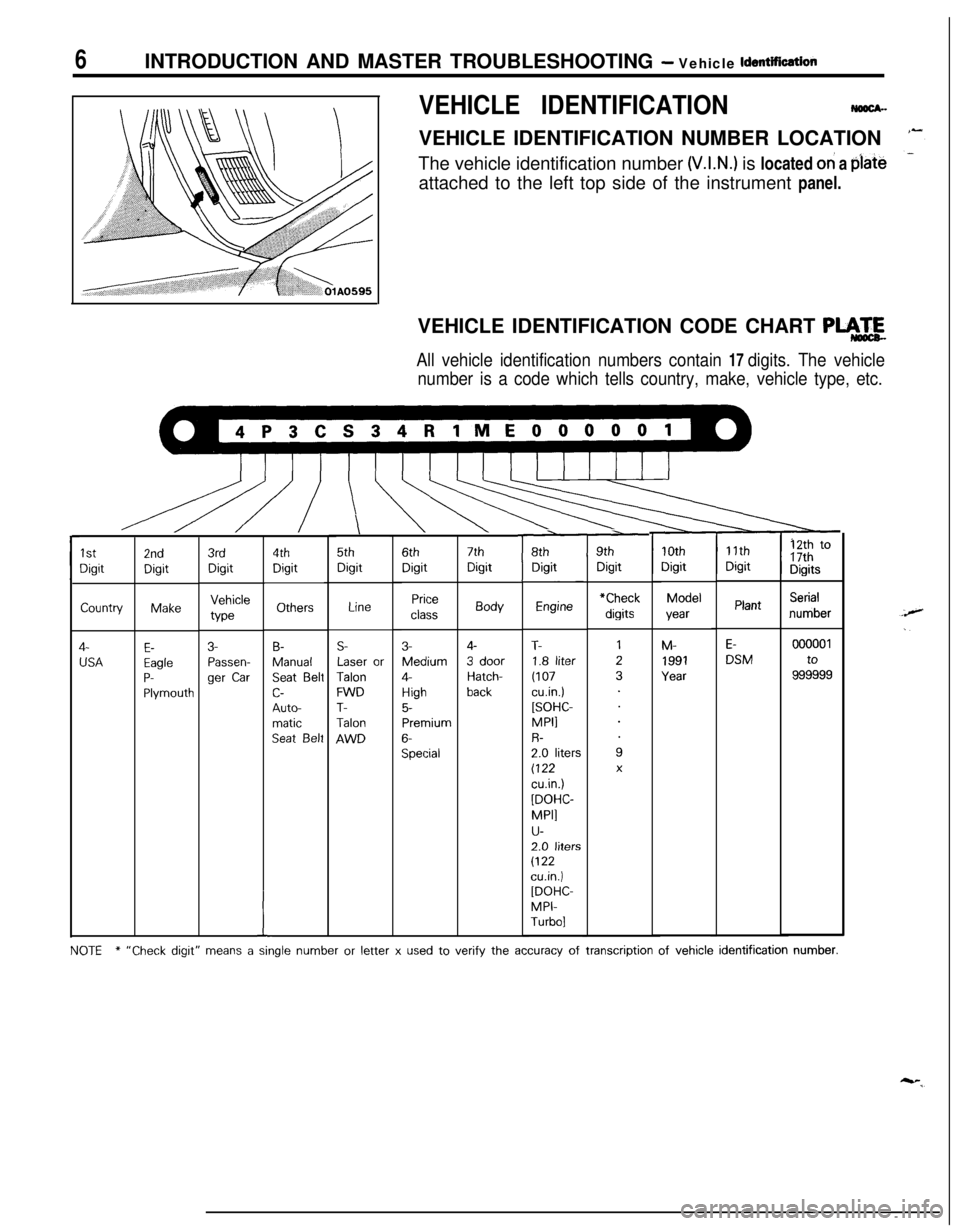
6INTRODUCTION AND MASTER TROUBLESHOOTING - Vehicle Identificetion
VEHICLE IDENTIFICATIONNmx-VEHICLE IDENTIFICATION NUMBER LOCATION
The vehicle identification number
(V.I.N.) is located oh a plate
attached to the left top side of the instrument panel.
VEHICLE IDENTIFICATION CODE CHART
PLA.4
All vehicle identification numbers contain 17 digits. The vehicle
number is a code which tells country, make, vehicle type, etc.
\5thDigit
r8thDigitr9thDigit
11thDigit12th to17thDigits
10thDigitModelyearM-
1991Year
7thDigitBody
4-
3 doorHatch-back
Engine
T-1.8 liter
(107cu.in.)[SOHC-MPI1R-2.0 liters(122
cu.in.)
[DOHC-
MPI]
u-2.0 liters
(122cuin.)[DOHC-MPI-Turbo]6thDigit
Price
class
3-Medium
4-
High5-Premium
6-Special
4thDigit
Others
B-Manual
Seat Beltc-
Auto-matic
Seat Belt
3rdDigitVehicleWe
3-Passen-ger
Car
2ndDigitMake
E-EagleP-Plymouth
1stDigitCountry
4-
USA
Serialnumber*CheckPlantLine
E-DSMS-Laser or
TalonFWDT-Talon
AWD
000001to
999999
I
NOTE* “Check digit” means a single number or letter x used to verify the accuracy of transcription of vehicle identification number.
Page 7 of 1216
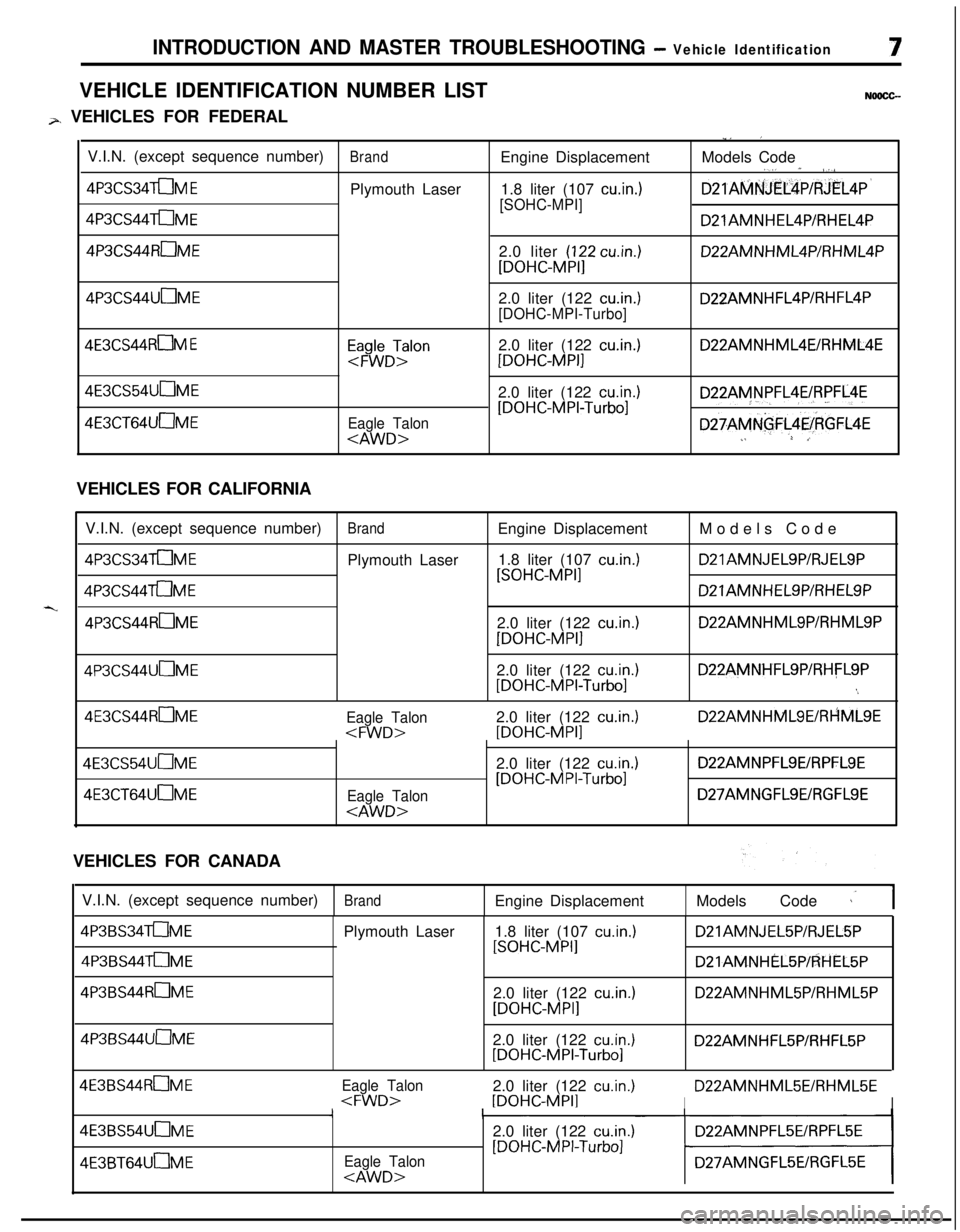
INTRODUCTION AND MASTER TROUBLESHOOTING - Vehicle IdentificationVEHICLE IDENTIFICATION NUMBER LIST
NOOCC--
p, VEHICLES FOR FEDERAL
,.. IV.I.N. (except sequence number)
BrandEngine DisplacementModels Code,,; * /./
4P3CS34aM EPlymouth Laser1.8 liter (107 cuin.)D21AMNJElXP/RJEL4P’
4P3CS44aME[SOHC-MPI]
D21AMNHEL4P/RHEL4P4P3CS44ROME2.0 liter
(122 cuin.)
[DOHC-MPI]D22AMNHML4P/RHML4P4P3CS44UuME2.0 liter (122
cu.in.)
[DOHC-MPI-Turbo]D22AMNHFL4P/RHFL4P
4E3CS44ROM EEap$DTrlon2.0 liter (122 cu.in.)
[DOHC-MPI]D22AMNHML4EIRHML4E4E3CS54UnME4E3CT64UOME
Eagle Talon
cu.in.)
[DOHC-MPI-Turbo]D22AMNPFL4EIRPFL4E
D27AMNGFL4E/kGFL4E.1L *,VEHICLES FOR CALIFORNIA
V.I.N. (except sequence number)
BrandEngine DisplacementModels Code
4P3CS34aMEPlymouth Laser1.8 liter (107 cu.in.)D21AMNJELSP/RJELSP
4P3CS44aME
[SOHC-MPI]D21AMNHELSP/RHELSP
4P3CS44RmME2.0 liter (122 cuin.)
[DOHC-MPI]
D22AMNHMLSP/RHMLSP4P3CS44UOME2.0 liter (122
cu.in.1[DOHC-MPI-Turbo]
D22AMNHFLSP/RHFLSP
‘.4E3CS44RuME
Eagle Talon2.0 liter (122 cu.in.1
D22AMNHMLSE/RHMLSE4E3CS54UOME4E3CT64UOME
Eagle Talon
cu.in.1[DOHC-MPI-Turbo]
D22AMNPFLSElRPFLSE
D27AMNGFLSE/RGFLSEVEHICLES FOR CANADA
V.I.N. (except sequence number)
BrandEngine DisplacementModels Code 1’1
4P3BS34aME
4P3BS44aMEPlymouth Laser1.8 liter (107
cu.in.1[SOHC-MPI]D21AMNJEL5P/RJEL5PD21AMNHiL5P/RHEL5P4P3BS44ROME
2.0 liter (122
cuin.)
[DOHC-MPI]D22AMNHML5P/RHML5P4P3BS44UuME
2.0 liter (122
cu.in.)[DOHC-MPI-Turbo]D22AMNHFL5P/RHFL5P4E3BS44ROME
Eagle Talon2.0 liter (122 cu.in.)D22AMNHML5EiRHML5E
Eagle Talon
cu.in.1
[DOHC-MPI-Turbo]
Page 8 of 1216
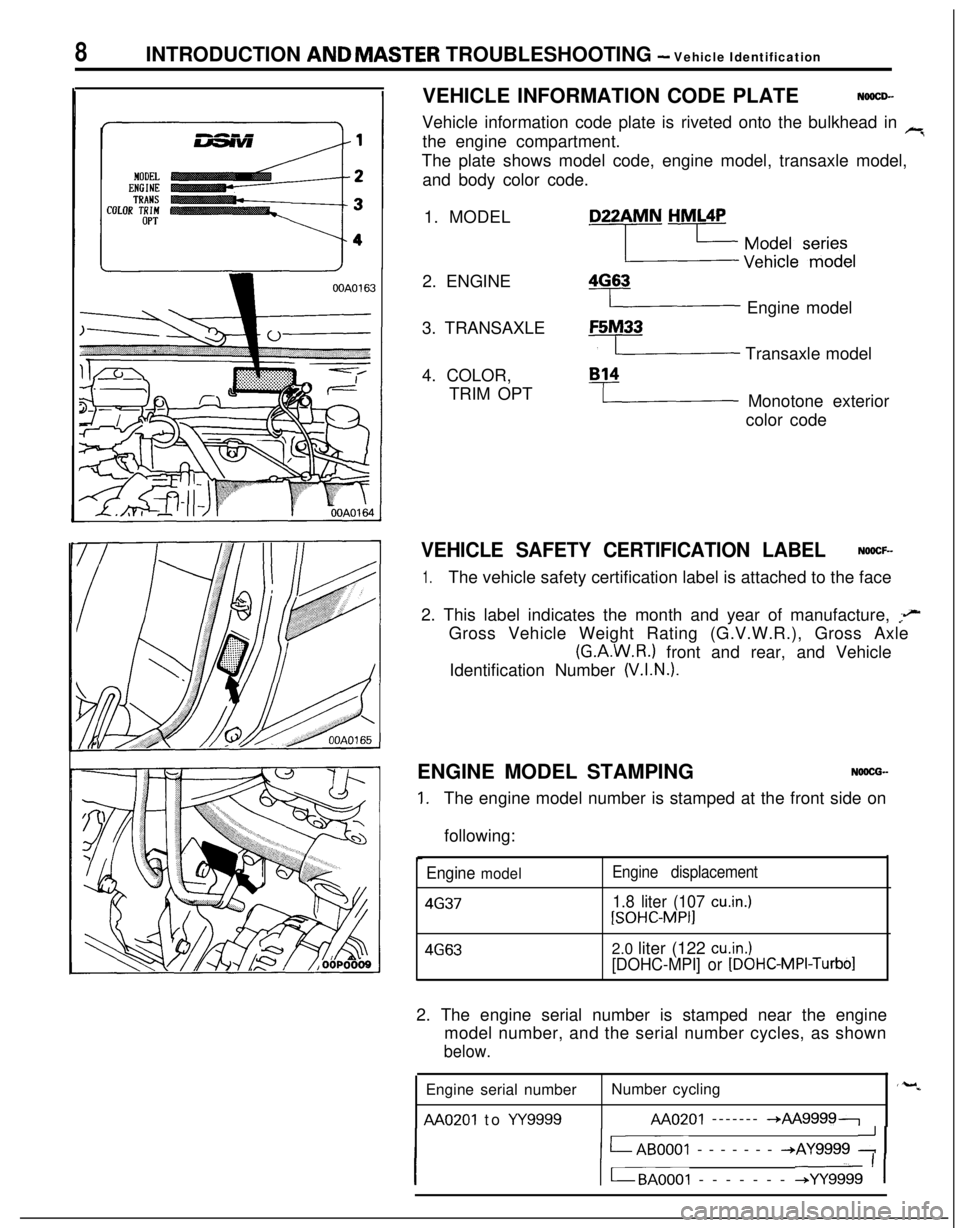
8INTRODUCTION AND MASTER TROUBLESHOOTING - Vehicle Identification
VEHICLE INFORMATION CODE PLATE
NOOCD-Vehicle information code plate is riveted onto the bulkhead in
rithe engine compartment.
The plate shows model code, engine model, transaxle model,
and body color code.
1. MODEL
2. ENGINE
3. TRANSAXLE
4. COLOR,
TRIM OPTD22AMN
HML4P
2 y$y:/e ‘f$$l
4G63
I Engine modelF5M33
y Transaxle model
B14
I Monotone exterior
color code
VEHICLE SAFETY CERTIFICATION LABELNOOCF-
1.The vehicle safety certification label is attached to the face
2. This label indicates the month and year of manufacture,
;eGross Vehicle Weight Rating (G.V.W.R.), Gross Axle
(G.A.W.R.) front and rear, and Vehicle
Identification Number
(V.I.N.).ENGINE MODEL STAMPING
NOOCG-
1.The engine model number is stamped at the front side on
following:
Engine model4637Engine displacement
1.8 liter (107 cu.in.)
[SOHC-MPI]
4G632.0 liter (122 cuin.)
[DOHC-MPI] or
[DOHC-MPI-Turbo]2. The engine serial number is stamped near the engine
model number, and the serial number cycles, as shown
below.Engine serial numberNumber cycling
AA0201 to w9999AA0201 ------- -*AA99997
I1 LAB0001 ------- +AY9999 : 1
I1 t-BAOOOI ------- +YY9999 ’ 1
‘-w
Page 9 of 1216
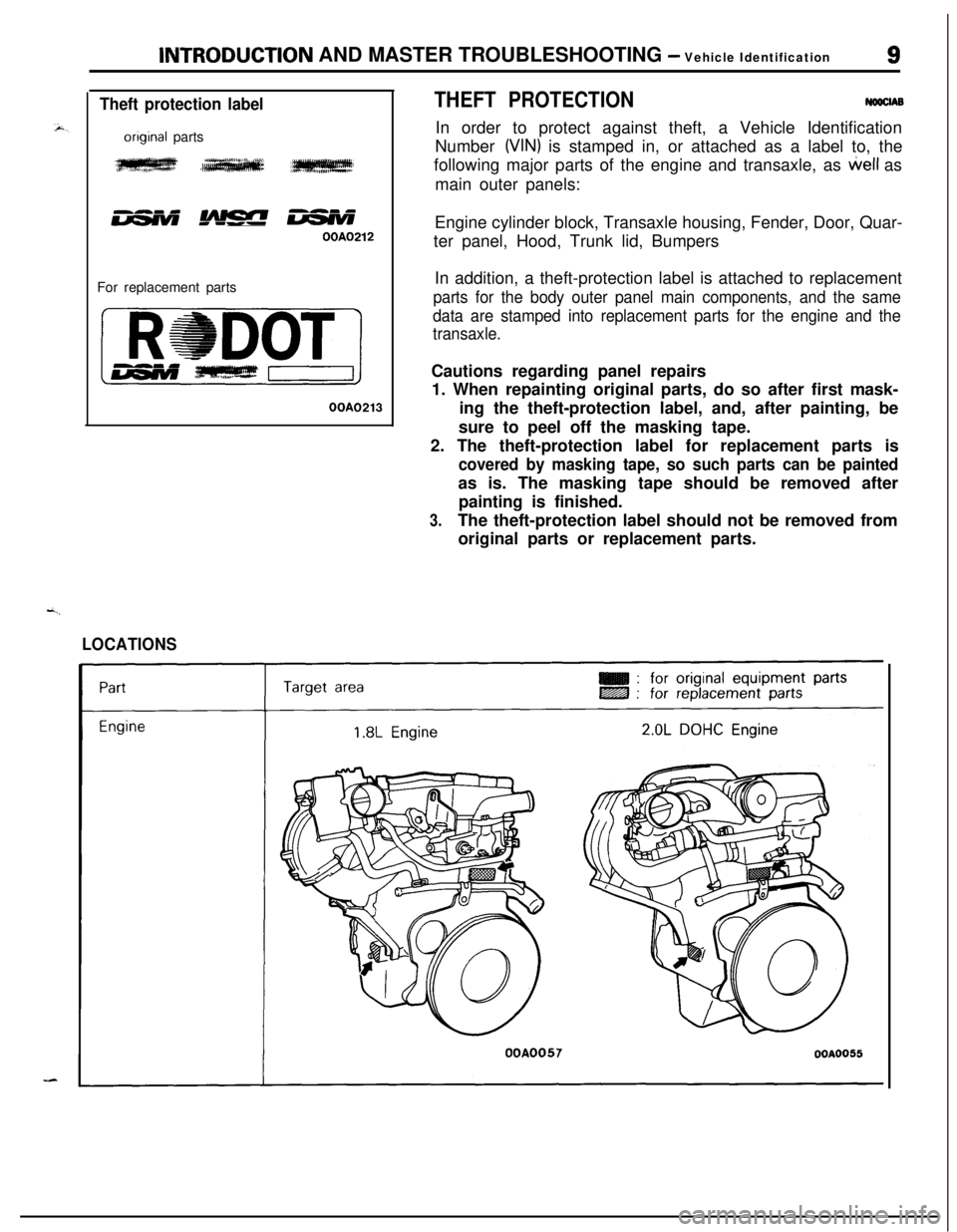
INTRODUCTlON AND MASTER TROUBLESHOOTING - Vehicle Identification9
Theft protection label
onginal parts
w ,IeIW
B ,w w
OOA0212For replacement parts
OOA0213
LOCATIONS
THEFT PROTECTIONNowlABIn order to protect against theft, a Vehicle Identification
Number
WIN) is stamped in, or attached as a label to, the
following major parts of the engine and transaxle, as
tiell as
main outer panels:
Engine cylinder block, Transaxle housing, Fender, Door, Quar-
ter panel, Hood, Trunk lid, Bumpers
In addition, a theft-protection label is attached to replacement
parts for the body outer panel main components, and the same
data are stamped into replacement parts for the engine and the
transaxle.Cautions regarding panel repairs
1. When repainting original parts, do so after first mask-
ing the theft-protection label, and, after painting, be
sure to peel off the masking tape.
2. The theft-protection label for replacement parts is
covered by masking tape, so such parts can be paintedas is. The masking tape should be removed after
painting is finished.
3.The theft-protection label should not be removed from
original parts or replacement parts.
OOA0057OOA0055
Page 14 of 1216
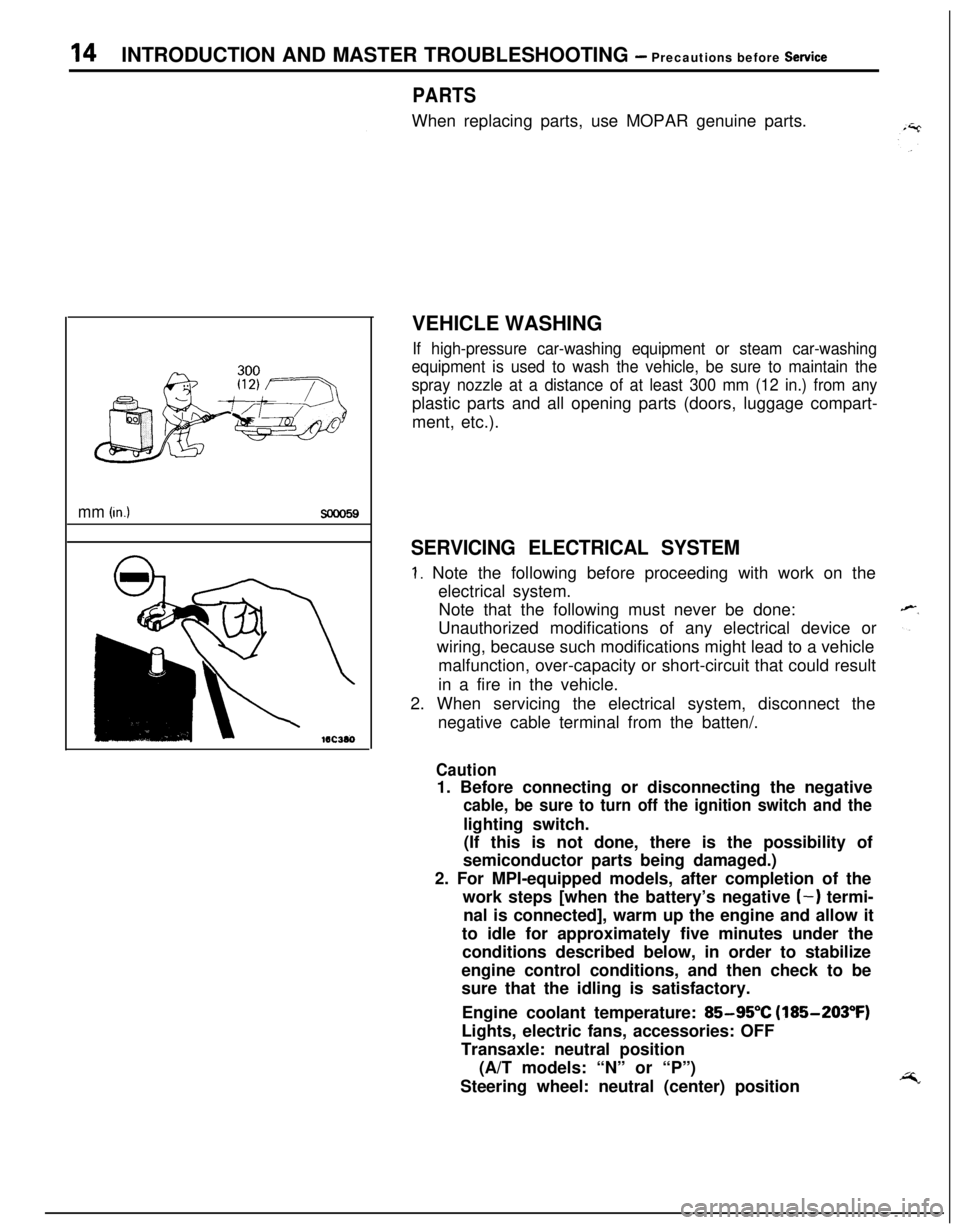
I4INTRODUCTION AND MASTER TROUBLESHOOTING - Precautions before Service
mm (In.1smo59
PARTSWhen replacing parts, use MOPAR genuine parts.
VEHICLE WASHING
If high-pressure car-washing equipment or steam car-washing
equipment is used to wash the vehicle, be sure to maintain the
spray nozzle at a distance of at least 300 mm (12 in.) from anyplastic parts and all opening parts (doors, luggage compart-
ment, etc.).
SERVICING ELECTRICAL SYSTEM
1. Note the following before proceeding with work on the
electrical system.
Note that the following must never be done:
Unauthorized modifications of any electrical device or
wiring, because such modifications might lead to a vehicle
malfunction, over-capacity or short-circuit that could result
in a fire in the vehicle.
2. When servicing the electrical system, disconnect the
negative cable terminal from the batten/.
Caution1. Before connecting or disconnecting the negative
cable, be sure to turn off the ignition switch and thelighting switch.
(If this is not done, there is the possibility of
semiconductor parts being damaged.)
2. For MPI-equipped models, after completion of the
work steps [when the battery’s negative
(-) termi-
nal is connected], warm up the engine and allow it
to idle for approximately five minutes under the
conditions described below, in order to stabilize
engine control conditions, and then check to be
sure that the idling is satisfactory.
Engine coolant temperature:
85-95°C (185-203°F)
Lights, electric fans, accessories: OFF
Transaxle: neutral position
(A/T models: “N” or “P”)
Steering wheel: neutral (center) position
Page 15 of 1216
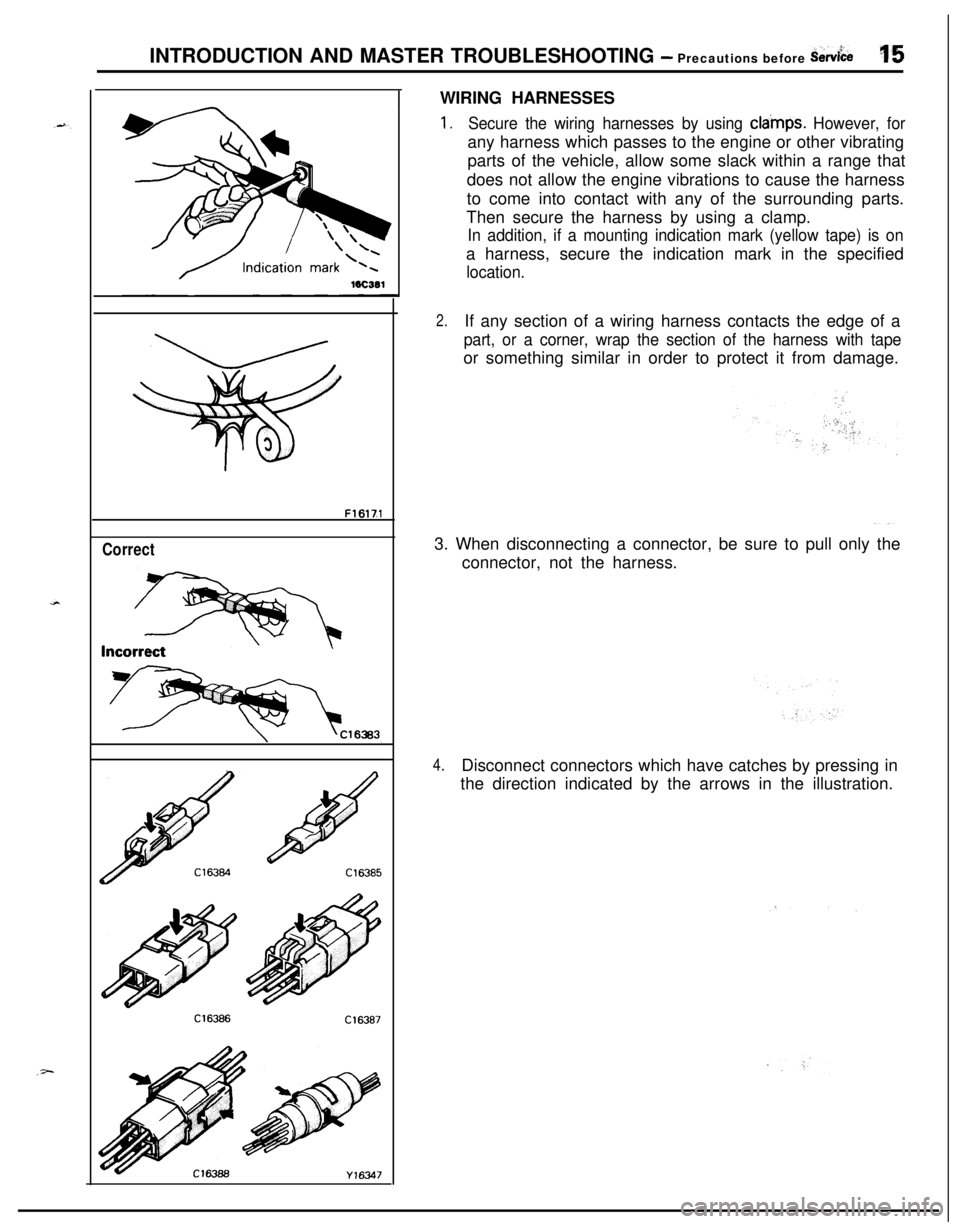
INTRODUCTION AND MASTER TROUBLESHOOTING - Precautions before Set&e15
F16171
Correct
Cl6385
Cl6367
Y16347WIRING HARNESSES
1.Secure the wiring harnesses by using cla’mps. However, forany harness which passes to the engine or other vibrating
parts of the vehicle, allow some slack within a range that
does not allow the engine vibrations to cause the harness
to come into contact with any of the surrounding parts.
Then secure the harness by using a clamp.
In addition, if a mounting indication mark (yellow tape) is ona harness, secure the indication mark in the specified
location.
2.If any section of a wiring harness contacts the edge of a
part, or a corner, wrap the section of the harness with tapeor something similar in order to protect it from damage.
3. When disconnecting a connector, be sure to pull only the
connector, not the harness.
4.Disconnect connectors which have catches by pressing in
the direction indicated by the arrows in the illustration.
Page 17 of 1216
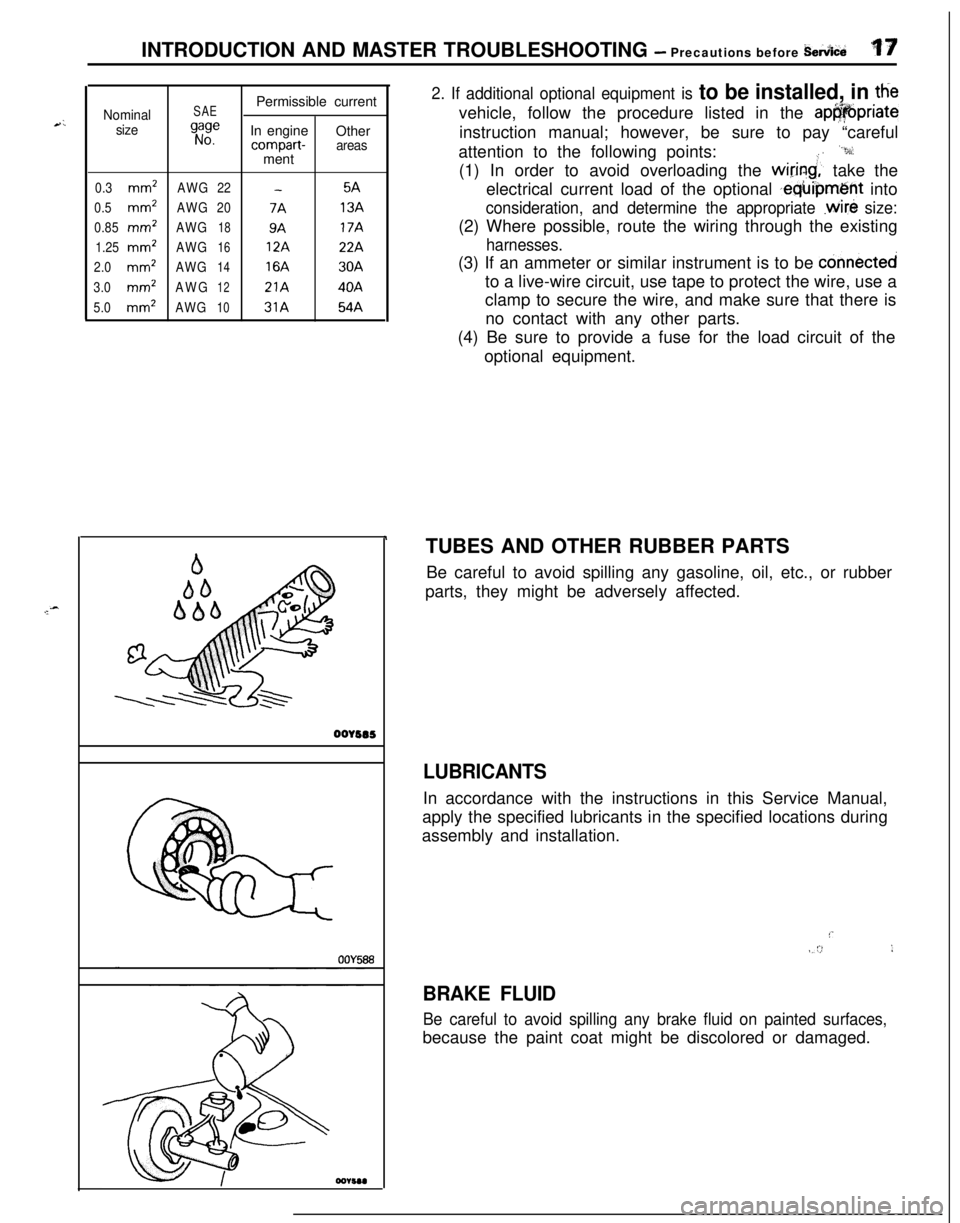
INTRODUCTION AND MASTER TROUBLESHOOTING - Precautions before Sew&e‘37
Nominal
sizeSAE
gi:ePermissible current
In engine
Othercompart-areasment
0.3mm2AWG22-5A
0.5
mm2AWG207A13A
0.85
mm’AWG189A17A
1.25
mm2AWG1612A22A
2.0mm2AWG1416A30A
3.0mm’AWG1221A40A
5.0mm2AWG1031A54A
r ‘.
oorsas
2. If additional optional equipment is to be installed, in ttievehicle, follow the procedure listed in the
ap@@priateinstruction manual; however, be sure to pay “careful
attention to the following points:
“9:(1) In order to avoid overloading the
wiring;’ take the
electrical current load of the optional
,equipment into
consideration, and determine the appropriate .wire size:(2) Where possible, route the wiring through the existing
harnesses.(3) If an ammeter or similar instrument is to be
connectedto a live-wire circuit, use tape to protect the wire, use a
clamp to secure the wire, and make sure that there is
no contact with any other parts.
(4) Be sure to provide a fuse for the load circuit of the
optional equipment.
TUBES AND OTHER RUBBER PARTS
Be careful to avoid spilling any gasoline, oil, etc., or rubber
parts, they might be adversely affected.
LUBRICANTSIn accordance with the instructions in this Service Manual,
apply the specified lubricants in the specified locations during
assembly and installation.
!’IV/ :>,I
BRAKE FLUID
Be careful to avoid spilling any brake fluid on painted surfaces,because the paint coat might be discolored or damaged.
Page 18 of 1216
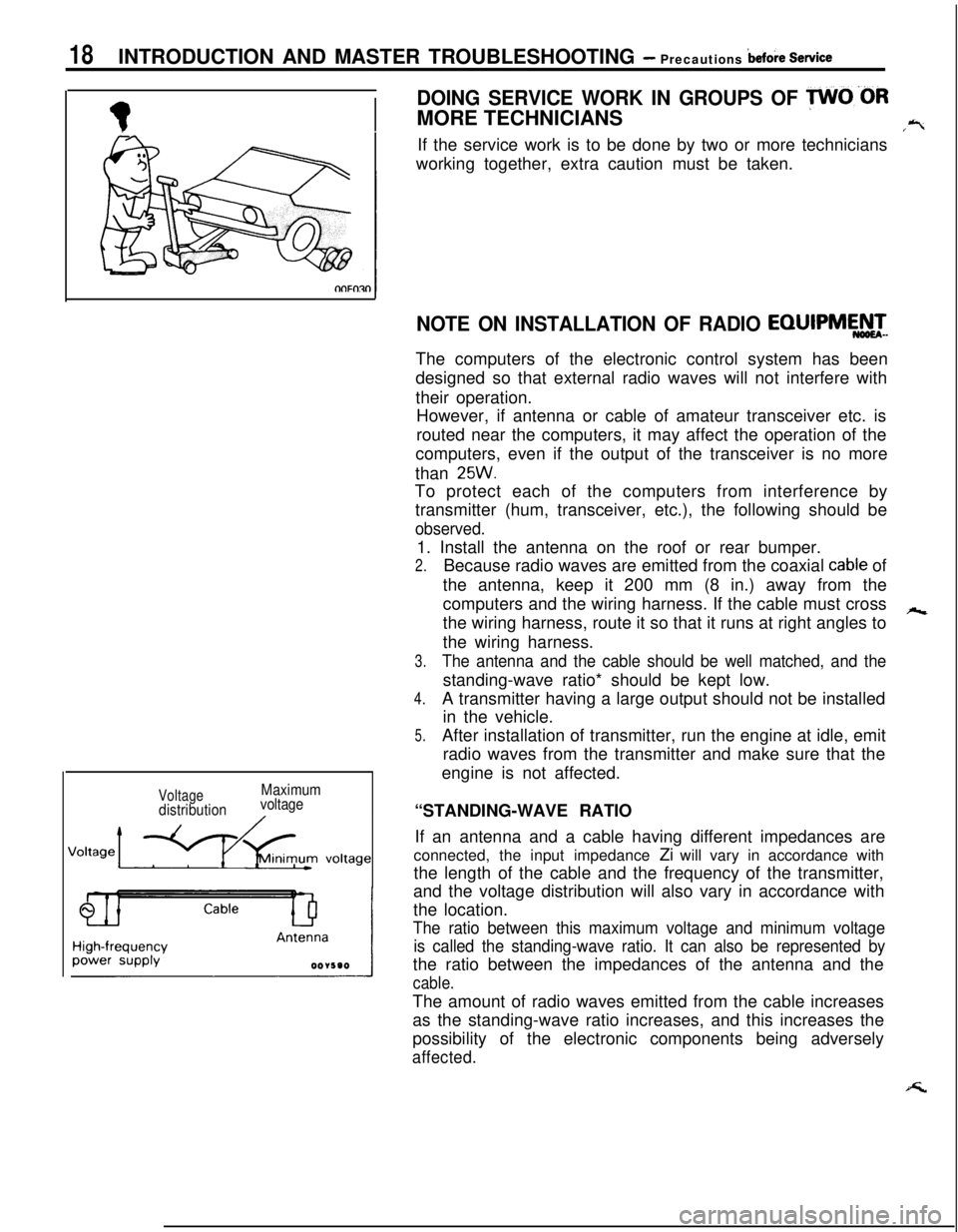
18INTRODUCTION AND MASTER TROUBLESHOOTING - Precautions b&ire Service
DOING SERVICE WORK IN GROUPS OF VO’bRMORE TECHNICIANS
.-I-7.IIf the service work is to be done by two or more technicians
working together, extra caution must be taken.
VoltagedistributionMaximum
voltage
NOTE ON INSTALLATION OF RADIO EQIJIPMEATeThe computers of the electronic control system has been
designed so that external radio waves will not interfere with
their operation.
However, if antenna or cable of amateur transceiver etc. is
routed near the computers, it may affect the operation of the
computers, even if the output of the transceiver is no more
than
25W.To protect each of the computers from interference by
transmitter (hum, transceiver, etc.), the following should be
observed.1. Install the antenna on the roof or rear bumper.
2.Because radio waves are emitted from the coaxial cable of
the antenna, keep it 200 mm (8 in.) away from the
computers and the wiring harness. If the cable must cross
hthe wiring harness, route it so that it runs at right angles to
the wiring harness.
3.The antenna and the cable should be well matched, and thestanding-wave ratio* should be kept low.
4.A transmitter having a large output should not be installed
in the vehicle.
5.After installation of transmitter, run the engine at idle, emit
radio waves from the transmitter and make sure that the
engine is not affected.
“STANDING-WAVE RATIO
If an antenna and a cable having different impedances are
connected, the input impedance Zi will vary in accordance with
the length of the cable and the frequency of the transmitter,
and the voltage distribution will also vary in accordance with
the location.
The ratio between this maximum voltage and minimum voltage
is called the standing-wave ratio. It can also be represented bythe ratio between the impedances of the antenna and the
cable.The amount of radio waves emitted from the cable increases
as the standing-wave ratio increases, and this increases the
possibility of the electronic components being adversely
affected.